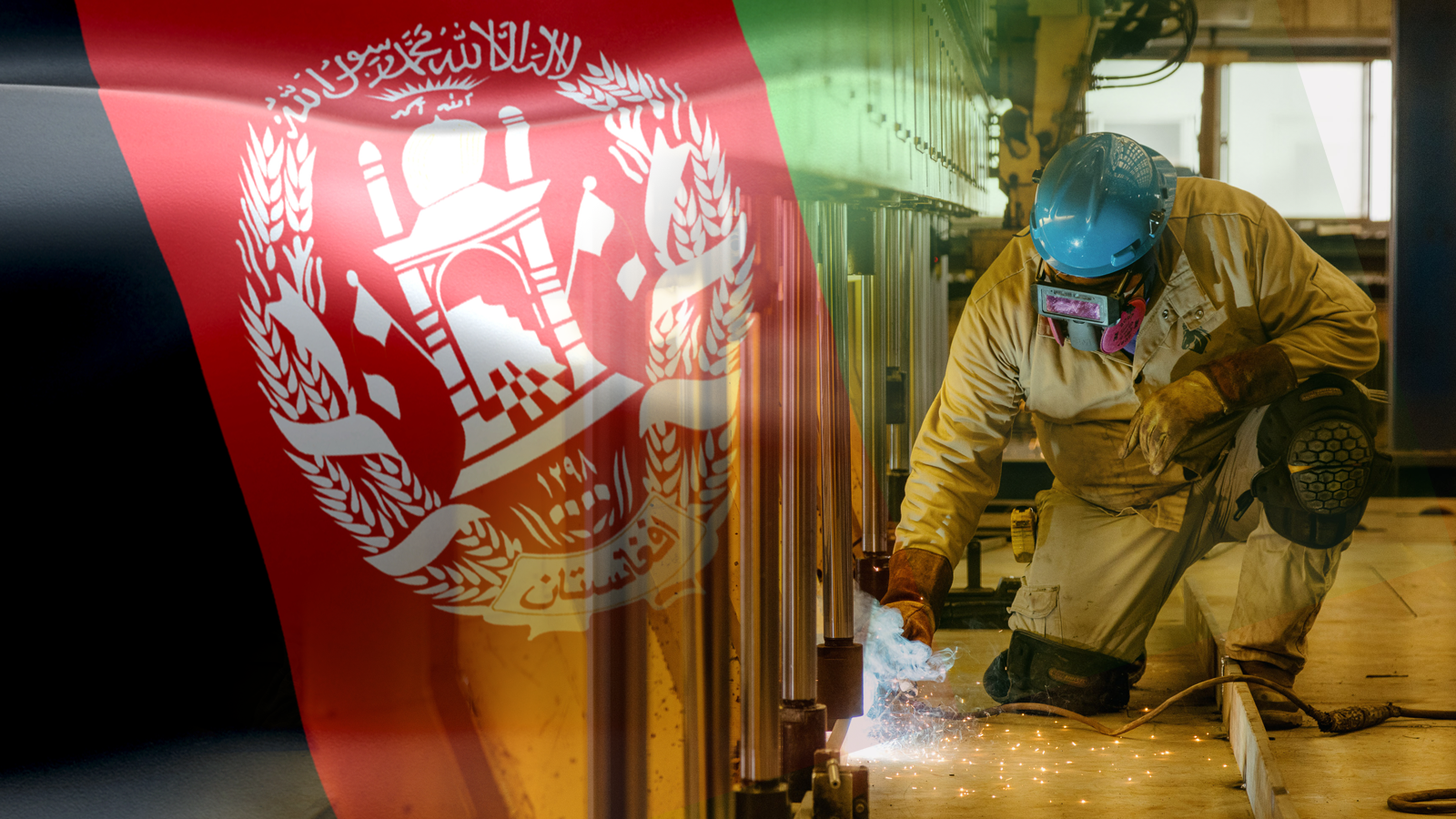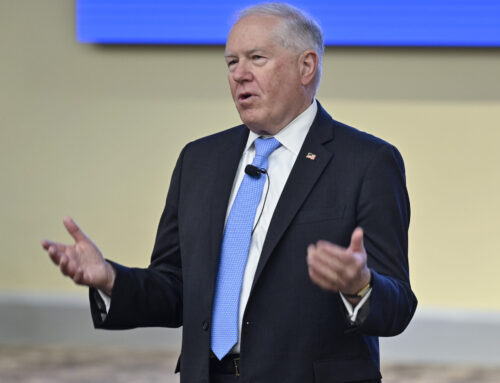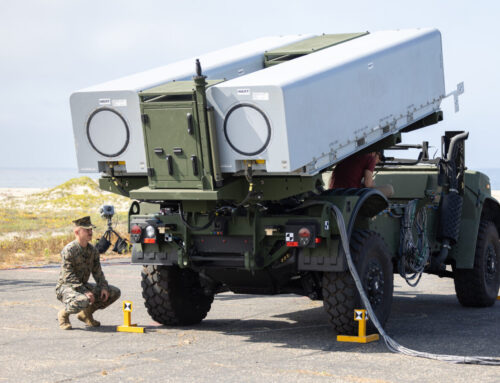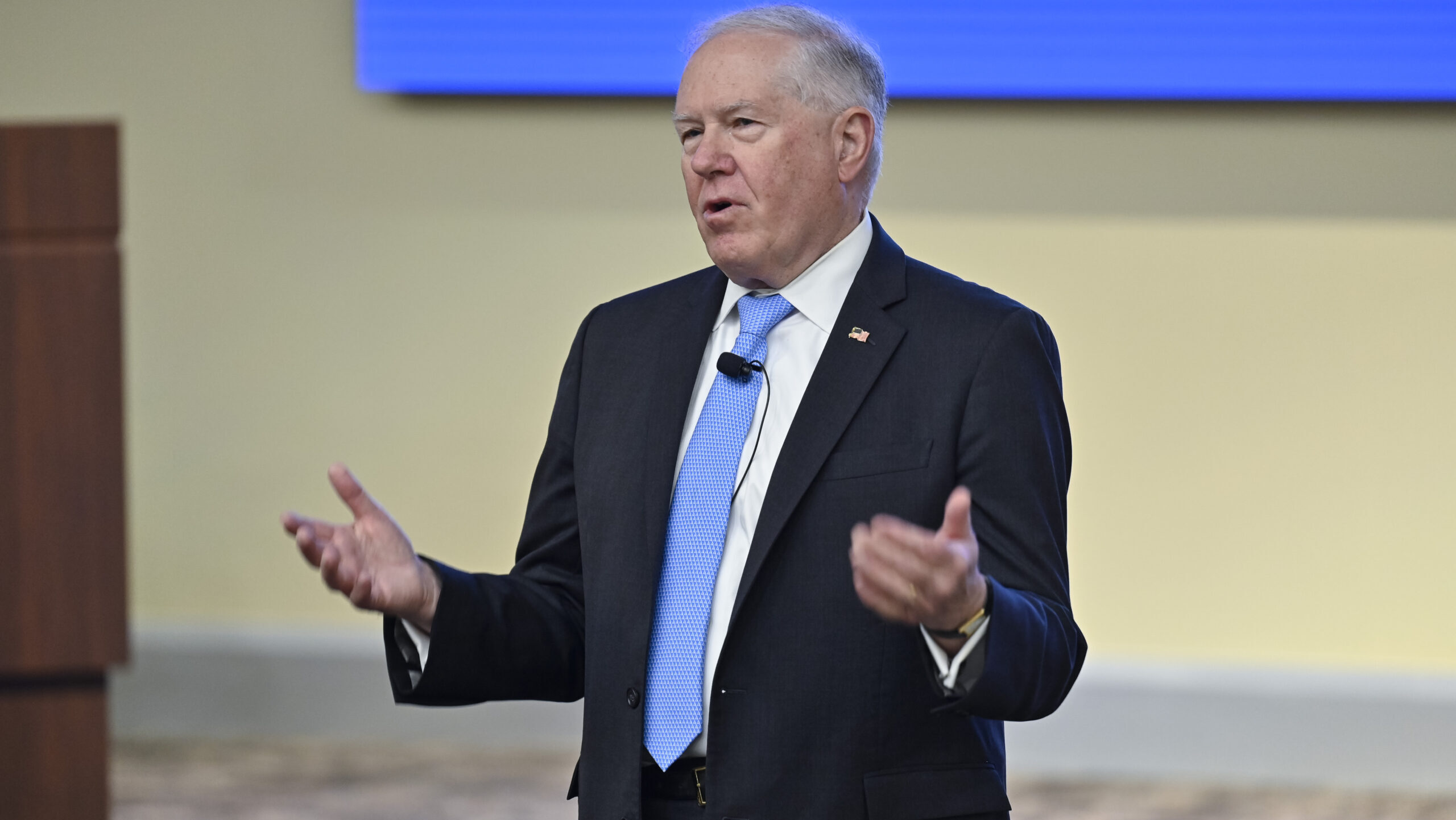A graphic showing a ship welder and the flag of Afghanistan. (Breaking Defense graphic, original images via Getty)
WASHINGTON — In 2020, as the Taliban was on the rise, Rafiullah Noori and his family uprooted from Afghanistan seeking a safer, more promising future in Northern Virginia. But Noori’s hopes for getting a college education were quickly crushed by the COVID-19 pandemic and economic realities, and he found himself delivering food for DoorDash.
Noori, then 20 years old, was desperate to find more stable work when one of his friends told him about the Accelerated Training in Defense Manufacturing program, a US Navy-funded training effort in Danville, Va., aimed at teaching adult students the manufacturing skills in high demand by the shipbuilding industry — especially the beleaguered submarine industrial base.
Four years later, he’s helping to build the National Security Multi-Mission Vessel, clocking in at Philly Shipyard every morning to do quality control for ships that will be used to train future merchant marine officers.
For Noori, whose father worked at the US embassy in Kabul, the opportunity allowed him to build what he called a “real career.”
“This industry changed my life,” he told Breaking Defense. (Breaking Defense is using a pseudonym for Noori at his request, as his extended family remains in Afghanistan.)
Noori is one of a handful of Afghan immigrants who have found a new life in the shipbuilding industry following the United States’ exit from Afghanistan and subsequent Taliban takeover of the country three years ago.
Afghan immigrants “have embraced patriotism and support for America, and often have done so with some significant personal risk,” Sen. Tim Kaine, D-Va., told Breaking Defense. “The fact that they’ve come here to start this new chapter in the US, and have decided, ‘Hey, look, I’ve been serving the security needs of the United States. Why don’t I continue to do that in a new way?’
“It’s enormously gratifying, and I think it’s a little bit of an indication of the fact that our defense industrial base is being creative and innovative.”
It’s also an injection of new blood into the shipbuilding industry at a time where it’s sorely needed. After years of consolidation and amid the retirement of its experienced workforce, the shipbuilding sector is starving for blue-collar talent to build new submarines and surface vessels in hot demand by the US Navy, US Coast Guard and the Maritime Administration.
RELATED: ‘They forget us’: How an Afghan Black Hawk pilot saw his country collapse from the air
Recruiting from the Afghan community is hardly a comprehensive solution for an industry that needs to hire tens of thousands of workers. But advocates see it as a potential path forward for the shipbuilding sector, both to help ease the labor shortage now and for the model it could provide for other immigrant groups in the future.
“This group of people don’t have anything and are coming here, that is a great motivation for somebody to learn a skill and do the best they can for their families,” Michael Giantomaso, Philly Shipyard’s manager of human relations, said of the Afghans looking for opportunities in shipbuilding. “All of our ancestors were immigrants at one point. And when you come over, you’ve got to start by learning a skill.”
Small Numbers, Big Potential
Noori found a job at Philly Shipyard through one of two programs that are a small but intriguing portion of a larger multi-million dollar jobs campaign by the Navy and shipbuilding industry.(Philly Shipyard doesn’t build Navy warships, but the shipyard has been of interest to Navy Secretary Carlos Del Toro as he has emphasized the importance of both naval and commercial shipbuilding.)
Noori attended a sixteen-week training program at the Virginia-based Accelerated Training in Defense Manufacturing (ATDM) institute, which has special resources in place for Afghan students in addition to the broader program. There’s also Philly Shipyard’s apprenticeship program, which recently started recruiting Afghans to take part in its latest class.
Neither ATDM or the Philly Shipyard programs were purpose-built for Afghan immigrants, but both have deliberately sought out Afghan participants. According to Rob Gorham, founder and chief executive of the nonprofit BlueForge Alliance, that’s because these programs see a chance to bolster numbers at shipbuilders and their supply chain while at the same time providing job opportunities to a population that may have previously worked to advance American interests during the Global War on Terror — often endangering their own lives or those of their loved ones in the process.
BlueForge Alliance, which is based in Texas, works as lead integrator for Navy and industry efforts to boost the submarine industrial base. The group said in a statement that it closely oversees the Philly Shipyard’s apprenticeship program, awarding funding in partnership with the US Navy that assisted in the hiring of Afghan apprentices and expanding current class sizes.
The numbers are still small. Afghan immigrants — like Noori, a graduate of ATDM — make up a miniscule portion of the overwhelmingly American group of students at the institute, said ATDM director Debra Holley. Of the 614 total people who have graduated the program since 2021, only 26 are Afghan immigrants and only 14 have moved into the shipbuilding industry. Only one Afghan participant is currently enrolled in the current session, running from August to December 2024.
Meanwhile, Philly Shipyard began recruiting Afghans as part of its most recent apprenticeship class, which started late 2023 and runs for three years total, said Giantomaso, who helps manage the apprenticeship program. BlueForge said seven Afghan immigrants were hired in the current cohort, and are currently undergoing their first year in the program.
Those numbers hardly put a dent into the amount of employees needed to reconstitute the submarine industrial base over the next 10 years — a requirement estimated to include about 100,000 blue-collar workers at General Dynamics Electric Boat and HII, the two main yards that produce submarines, as well as an additional 17,000 employees throughout the supply chain.
RELATED: At Ingalls, plenty of space for shipbuilding, but ramping up workforce will be the challenge
Other shipbuilders are also in the midst of a hiring spree, with Austal in January 2023 announcing plans to hire 1,200 workers over 18 months, according to Alabama news outlet AL.com.
But Gorham argued that, given shipbuilders’ recruitment challenges, the small success of introducing several dozen Afghan immigrants to the shipbuilding industry should be celebrated alongside other workforce development initiatives that attracted 10,000 new workers over the past year.
“We are literally competing with fast food. There are signs on some of these fast food restaurants that say, ‘Hey, come work for me and I’ll pay you 50 grand,’” Gorham said.
U.S. Air Force loadmasters and pilots assigned to the 816th Expeditionary Airlift Squadron, load passengers aboard a U.S. Air Force C-17 Globemaster III in support of the Afghanistan evacuation at Hamid Karzai International Airport (HKIA), Afghanistan, Aug. 24, 2021. (U.S. Air Force photo by Master Sgt. Donald R. Allen)
New Skills For a New Start
While China has expanded its shipbuilding industrial base, public and private shipyards in the United States have weathered fluctuations in defense spending as well as an overall decline in commercial shipbuilding that has led to a contraction in the shipbuilding industrial base, the Pentagon said in its national defense industrial strategy released earlier this year.
Those conditions have resulted in a shipbuilding workforce that isn’t sized to meet current demands, particularly the submarine industrial base, which “requires unique skill sets and extensive training — such as nuclear welding — that is proving difficult to acquire,” the Pentagon said in the strategy. As of fiscal year 2022, the Navy was about 1,200 workers short at its public shipyards.
Training initiatives like ATDM and Philly Shipyard’s apprenticeship program provide interested candidates a way to break into the shipbuilding industry without having to pay for technical training out of pocket.
Ahmad was a journalist working for publications like Voice of America and the Associated Press before he said he was forced to leave Afghanistan in September 2021 after the Taliban took control of the country. Like Noori, he ended up attending ATDM after his arrival in the US. (Breaking Defense is using a pseudonym for Ahmad at his request, as his family remains in Afghanistan.)
For him, ATDM provided a way to learn a trade — in his case, additive manufacturing — without having to worry about how to pay for housing or transportation expenses.
Most of the Afghans who have gone through the program are former members of the Afghan military or have worked closely with the US military or government, said Ahmad, who now works for ATDM as an interpreter and liaison for Afghan students currently going through the program.
Beyond seeking new skills that can lead to stable, well-paying employment, “they really want to serve this country as well,” he said. “There are some [former] students who have been working for SIB [submarine industrial base] companies for more than two years. …They’re really happy.”
Beyond additive manufacturing, students can learn trades such as machining, welding and quality control — the course Noori took — and also receive training on soft skills such as resume building and job interviews.
ATDM, which will train 576 people in 2024, aims to scale up its throughput to a thousand students a year by 2026, Holley said. About 86 percent of students finish the program, and 91 percent of the latest class of graduates found jobs in the shipbuilding industry, mostly with companies deeper in the supply chain rather than prime contractors like Electric Boat or HII.
RELATED: ICE PACT: Why the US had to recruit help in race with Russia, China for Arctic icebreakers
However, it’s difficult to scale up Afghan participation in the program in part because of strict requirements that program participants be either US citizens or have a permanent work visa, Holley said.
Language is another barrier: While all participants are required to know English, Afghan students may not be familiar with manufacturing terminology, including some words that may not have a direct translation in their native Farsi. Ahmad has translated technical manuals and instructional videos into Farsi to help Afghan students pick up manufacturing skills more efficiently, but most Afghan students are still coming into the program with little to no experience in the trades they are learning.
Overall, Holley said ATDM has been successful at helping its Afghan graduates find careers in the shipbuilding industry, “It just takes a little more matching and talking with the companies about what their citizenship status is, what job openings they have — just a little more finesse.”
At Philly Shipyard, Giantomaso noted that Afghan workers in the program are already receiving union pay and benefits as they learn one of five disciplines: shipbuilding, welding, outfitting, machine operation and maintenance.
The company is hopeful that, if its first cohort of Afghan apprentices is able to get through the program and begin working their way through up the ladder, they can help recruit new prospects from among their families, friends and neighbors and make the shipbuilding industry more attractive to the Afghan diaspora, Giantomaso said.
Around 100 Afghan candidates had expressed interest in the program last year, but an overwhelming majority dropped out during the recruitment phase after touring a ship and observing working conditions where employees are subjected to an outdoor industrial environment.
“That doesn’t mean we’re not going to try it again,” he said.
A petroleum tanker stands while being built at the Aker Philadelphia Shipyard in Philadelphia, Pennsylvania, U.S., on Tuesday, June 19, 2012. The shipyard, the largest manufacturing business in Philadelphia, employs up to 1,200 workers and generates $230 million annually to the regional economy, according to their website. Photographer: Bradley C. Bower/Bloomberg via Getty Images
Opening The Spigot
With the United States in dire need of workers, several top officials on Capitol Hill and within the Navy have asked: Why not build a new manufacturing corps from the millions of people hoping to immigrate to America?
In April, Del Toro, the Navy’s top civilian, called on lawmakers to “open up the spigot on legal immigration” to allow blue-collar workers to move to the United States and take shipbuilding jobs, according to Janes.
RELATED: How SECNAV’s claims about South Korean, Japanese shipbuilders do and don’t add up
The idea has also been bolstered by Rep. Adam Smith — the top Democrat on the House Armed Services Committee — who said during an American Enterprise Institute event in May that the United States is “overwhelmed with the sheer volume of people who are coming at our borders” while it faces a “massive workforce shortage” in certain industries.
“What could we possibly do here that might help address those two issues? We can issue some work visas and we can bring some people in and train them to work in a variety of different areas,” Smith said, adding that the “defense industrial base and shipbuilding [is a] pretty good place to start, because there’s a huge need and that’s part of the reason that we’re falling behind.”
Speaking to Breaking Defense this week, Kaine said he agreed that the United States needs broad workforce-based immigration reform to meet American labor needs not only in the realm of shipbuilding, but also in areas such as agriculture, health care, hospitality and other construction and manufacturing trades.
“The refusal to do that will start to be a real choke point on American productivity,” he said.
Just as ATDM could be a model for other shipbuilding workforce development programs, Kaine posited that its outreach to immigrants could also be duplicated for the thousands of Ukrainian humanitarian parolees who were admitted to the United States after Russia’s invasion of Ukraine in 2022.
“They’re passionate about protecting Ukrainian democracy, and they have a gratitude that the US is trying to do that,” Kaine said. “That could be a really good source for potential workers.”
With training from ATDM, finding employment was no problem for Noori, who said he was given a job offer from Philly Shipyard shortly before his graduation from the institute in May 2023. He began work at the shipyard two months later — a start date he intentionally prolonged so that he could go back to Afghanistan for his brother’s wedding.
In the beginning, Noori didn’t think he’d stick with the job. He questioned whether he’d enjoy working in the bustling, noisy environment of the shipyard, exposed to bad weather and potential hazards. However, Noori quickly found that his curious, detail-oriented nature made him a good fit for the quality assurance job, and grew to “really like” the process of surveying the ship, measuring each part to ensure it meets specifications, he said.
“Now I think I found that career for myself,” he said.











